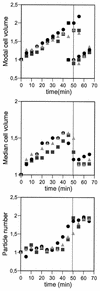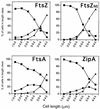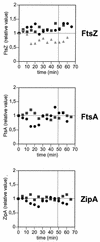Concentration and assembly of the division ring proteins FtsZ, FtsA, and ZipA during the Escherichia coli cell cycle
- PMID: 12754232
- PMCID: PMC155373
- DOI: 10.1128/JB.185.11.3344-3351.2003
Concentration and assembly of the division ring proteins FtsZ, FtsA, and ZipA during the Escherichia coli cell cycle
Abstract
The concentration of the cell division proteins FtsZ, FtsA, and ZipA and their assembly into a division ring during the Escherichia coli B/r K cell cycle have been measured in synchronous cultures obtained by the membrane elution technique. Immunostaining of the three proteins revealed no organized structure in newly born cells. In a culture with a doubling time of 49 min, assembly of the Z ring started around minute 25 and was detected first as a two-dot structure that became a sharp band before cell constriction. FtsA and ZipA localized into a division ring following the same pattern and time course as FtsZ. The concentration (amount relative to total mass) of the three proteins remained constant during one complete cell cycle, showing that assembly of a division ring is not driven by changes in the concentration of these proteins. Maintenance of the Z ring during the process of septation is a dynamic energy-dependent event, as evidenced by its disappearance in cells treated with sodium azide.
Figures





Similar articles
-
A specific role for the ZipA protein in cell division: stabilization of the FtsZ protein.J Biol Chem. 2013 Feb 1;288(5):3219-26. doi: 10.1074/jbc.M112.434944. Epub 2012 Dec 11. J Biol Chem. 2013. PMID: 23233671 Free PMC article.
-
Recruitment of ZipA to the septal ring of Escherichia coli is dependent on FtsZ and independent of FtsA.J Bacteriol. 1999 Jan;181(1):167-76. doi: 10.1128/JB.181.1.167-176.1999. J Bacteriol. 1999. PMID: 9864327 Free PMC article.
-
Escherichia coli ZipA Organizes FtsZ Polymers into Dynamic Ring-Like Protofilament Structures.mBio. 2018 Jun 19;9(3):e01008-18. doi: 10.1128/mBio.01008-18. mBio. 2018. PMID: 29921670 Free PMC article.
-
In the beginning, Escherichia coli assembled the proto-ring: an initial phase of division.J Biol Chem. 2013 Jul 19;288(29):20830-20836. doi: 10.1074/jbc.R113.479519. Epub 2013 Jun 5. J Biol Chem. 2013. PMID: 23740256 Free PMC article. Review.
-
E. coli Cell Cycle Machinery.Subcell Biochem. 2017;84:27-65. doi: 10.1007/978-3-319-53047-5_2. Subcell Biochem. 2017. PMID: 28500522 Review.
Cited by
-
Cell age dependent concentration of Escherichia coli divisome proteins analyzed with ImageJ and ObjectJ.Front Microbiol. 2015 Jun 11;6:586. doi: 10.3389/fmicb.2015.00586. eCollection 2015. Front Microbiol. 2015. PMID: 26124755 Free PMC article.
-
A specific role for the ZipA protein in cell division: stabilization of the FtsZ protein.J Biol Chem. 2013 Feb 1;288(5):3219-26. doi: 10.1074/jbc.M112.434944. Epub 2012 Dec 11. J Biol Chem. 2013. PMID: 23233671 Free PMC article.
-
Isolation, characterization and lipid-binding properties of the recalcitrant FtsA division protein from Escherichia coli.PLoS One. 2012;7(6):e39829. doi: 10.1371/journal.pone.0039829. Epub 2012 Jun 27. PLoS One. 2012. PMID: 22761913 Free PMC article.
-
Bacterial cell division: assembly, maintenance and disassembly of the Z ring.Nat Rev Microbiol. 2009 Sep;7(9):642-53. doi: 10.1038/nrmicro2198. Nat Rev Microbiol. 2009. PMID: 19680248 Review.
-
Ring, helix, sphere and cylinder: the basic geometry of prokaryotic cell division.EMBO Rep. 2003 Jul;4(7):655-60. doi: 10.1038/sj.embor.embor885. EMBO Rep. 2003. PMID: 12835751 Free PMC article.
References
-
- Bouché, F., and J. P. Bouché. 1989. Genetic evidence that DicF, a second division inhibitor encoded by the Escherichia coli dicB operon, is probably RNA. Mol. Microbiol. 3:991-994. - PubMed
Publication types
MeSH terms
Substances
LinkOut - more resources
Full Text Sources
Molecular Biology Databases

